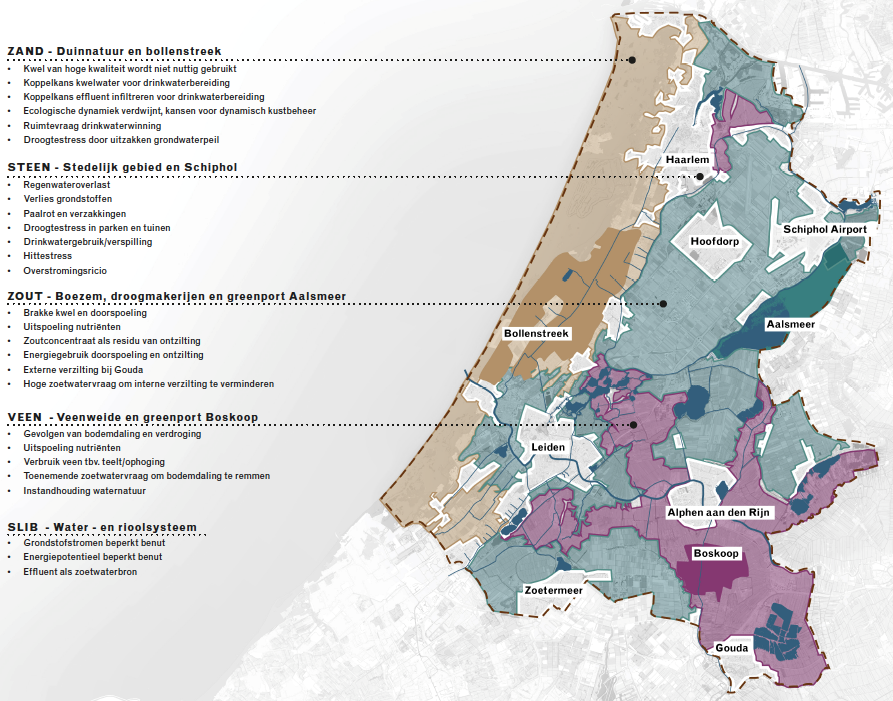How can the Hoogheemraadschap van Rijnland district water control board contribute to major taskings?
The main task of the Hoogheemraadschap van Rijnland district water control board is to protect the area against flooding and waterlogging, and to ensure a sufficient supply of clean water. In addition, the district water board aims to contribute to such major taskings as climate adaptation, the circular economy, and the energy transition. Since the water system is closely intertwined with these major taskings, the board has commissioned a study into optimum ways to substantiate its role. The report entitled De Blauwe Lens [The Blue Lense] outlines three perspectives.
How has the study been set up?
The design study was intended to develop perspectives from which the district water board could contribute to the societal taskings. It has been conducted by landscape architects, district water board administrators and policymakers, and a range of experts. In collective working sessions, they have mapped out the taskings and explored options for linking the water system to these taskings. The landscape architects supervising the process have summarised the findings into maps and visualisations. This has generated a picture of the main challenges and potential solutions. Ultimately, the agencies elaborated three perspectives, in collaboration with the district water board.

Perspective 1: Future-proofing based on core tasks
In the first perspective, the district water board is confining its operations to its core tasks. This entails that it will adopt technological innovations to optimise the current water system, in order to cope with the effects of climate change. The district water board will define the boundaries of what is feasible in the area. In addition, it will pursue sustainability in accordance with the prevailing standards and convert to energy-neutral and circular working methods wherever possible.
Perspective 2: Capitalising on societal values
In the second perspective, the district water board is guided by societal values. It will expand its activities to have the water system foster, e.g., energy provision and biodiversity. The current water system will be developed further in the purview of multi-functional utilisation. This may involve sub-optimum solutions in terms of actual water management. Suppose, for example, that farmland will need to be interspaced with parcels of nature in order to boost biodiversity. This will require, e.g., more measuring sections, since the natural environment and farmland require different forms of water level management.
Perspective 3: Water system is guiding
In the third perspective, the district water board will plan the water system as natural and climate-resilient as possible. This also entails that the water system will be leading in terms of spatial development, and that the district water board will have a directive role. This will involve, for example, higher groundwater levels that keep pace with the seasons. As a result, occasionally the water supply will run dry, whereas on other occasions, areas will have an excess of water. This calls for major investments in climate adaptation, such as houses that can cope with both high and low water levels, and urban greenery that is resilient to such changes. The water system itself will become simpler and more resilient.

How is the district water board using the perspectives?
The Hoogheemraadschap van Rijnland district water control board is using the perspectives as a source of inspiration for the decision-making process and dialogues with local residents. The perspectives provide input for environmental visions and other planning processes. In addition, the district water board is using the report to draw up a vision document for coping with climate change, and to outline its own role in these efforts. This vision document, which will be embedded in the district water board’s new water management programme, will be supported by the map images from the Blue Lense report.
How are the perspectives helping the district water board?
By considering a complex tasking from three perspectives, the district water board will have a better overview of the tasking. As the perspectives are not mutually exclusive, the district water board will not need to make any firm choices. It will determine its ultimate course of action in consultation with its partners on the basis of risk dialogues. Practical experience has taught that considerations will only crystallise in meetings on an actual project or plan at a specific location.

What does the district water board intend to accomplish in the end?
The Hoogheemraadschap van Rijnland district water control board is committed to properly embedding the importance of water and the soil in spatial processes. For that reason, it is important for the district water board to be involved in such processes right from the start. The Blue Lense report helps to achieve this goal, because it explains why it is vitally important to focus on water as one of the guiding principles in the sustainable planning of our living environment. The district water board expects that the perspectives will be especially helpful for making smart combinations, both between regions and between short-term and long-term measures.
Can the perspectives also be used in other regions of the Netherlands?
This three-perspective approach lends itself well to application in other regions. However, the taskings and solutions may differ, depending on the situation in a particular area. This spatial strategy combines all the potential taskings at issue in an area. The main lesson to be learned is that such a spatial strategy can present district water boards with unexpected new insights and options.
Contact persons
Erwin de Groot / Veronique Loeffen
Hoogheemraadschap van Rijnland
Erwin.groot@rijnland.net / veronique.loeffen@rijnland.net
